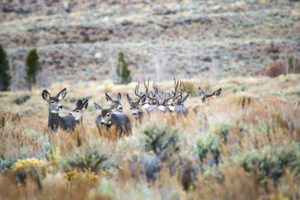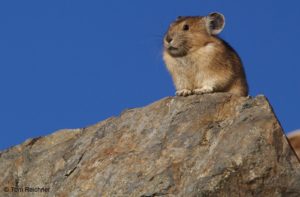We have much more to do and your continued support is needed now more than ever.
Last Day to Tell the Environmental Protection Agency to Keep the Clean Power Plan!
Why gutting the Clean Power Plan puts wildlife and public lands at risk

The Clean Power Plan was meant to be the first step along a path that would lead to substantial carbon emission reductions. The Plan would have been the first ever federal rule to reduce pollution from power plants, the second largest source of greenhouse gas emissions in the United States. These emissions have already led to grave environmental impacts by fueling climate change. If implemented, the Clean Power Plan would cut that pollution by 32 percent below 2005 levels by 2030, helping lessen climate risks for people and wildlife alike. But, did you know that the Clean Power Plan would help protect public lands as well?
Take ActionClimate change is impacting landscapes across the United States, especially public lands in the West. Wildlife found on public lands are already facing a host of threats, including invasive species, wildlife disease, and habitat loss and fragmentation. Climate change is expected to amplify these impacts and add a host of additional threats, including higher temperatures and drought. As the impacts of climate change continue to develop and spread across western public lands, the risk of significant biodiversity loss is growing, leading to a wildlife crisis.
Our new report Reversing America’s Wildlife Crisis lays out the challenges and a path for recovery.
In the United States, one-third of wildlife species are at risk due to a number of factors. Climate change is accelerating that loss. In fact, scientists conclude that food webs, species distribution, and other ecological processes are already being affected by human-caused climate change. Public lands support thousands of species and are a stronghold for many vulnerable wildlife that need large blocks of land to roam. Protecting these lands from the worsening impacts of climate change is critical.
The below examples highlight how climate change affects wildlife and public lands, and demonstrate how biodiversity loss is becoming a real problem.
Migration timing

Public lands host one of the largest land based migrations in North America—the mule deer migration in Wyoming.
Mule deer time their migration in Wyoming to follow the spring greening as they move from lower winter habitat to higher summer habitat. As seasonal change is altered by a warming climate, these deer are struggling to time their migrations to match the “green wave” of new growth.
Low snowpack
Lower snowpack (layers of high-altitude, compressed snow that melt slowly) is also a threat to wildlife and public lands. Snowmelt supplies about 60 to 80 percent of the water in major western river basins, including the Columbia, Missouri, and Colorado Rivers. This snowmelt is also the primary water supply for about 70 million people. Lower winter snowpack will lead to reduced stream flow during the summer months, which will impact temperature sensitive aquatic species like trout, and amphibians like frogs and newts. Scientists estimate that one-third of the current cold water fish habitat in the Pacific Northwest will be unsuitable by the end of the century. Fishing on public lands is a favorite American pastime, but fishing may be increasingly restricted as a result of low stream flows, hotter water, and reduced fish populations.
Megafires
The length of the fire season and the area burned by megafires—or catastrophic wildfires—have increased as a result of the warmer, drier conditions resulting from climate change. These conditions weaken trees in our national forests and parks and make them more vulnerable to unnaturally hot and severe fires. Drought weakened forests are also susceptible to pest epidemics, which further deteriorate and kill trees and can spread over a large area in increasingly warm weather, adding new fodder to wildfires. New fire regimes are also allowing the spread of invasive species like cheatgrass, which thrives in disturbed landscapes and is decimating the sagebrush habitat that sage grouse and other wildlife depend on. Megafires and the environmental impacts that result from them can lead to hunting restrictions as habitat is lost and degraded, and wildlife populations need more time to recover.
Rising temperatures

Public lands also support climate sensitive species, such as American pika. These small rabbit like creatures live on high elevation rocky slopes and are suffering from the effects of rising temperatures. While some populations of pika seem to be able to adapt to a changing climate, high elevation populations in the Sierra Nevada Mountains and the Northwestern Great Basin have not been as lucky. Some populations of pika in the Lake Tahoe area of California have been wiped out entirely, a shocking loss to wildlife lovers and one of the first recorded local extinctions of a species resulting directly from climate change. Local weather data shows a 28°F rise in average temperatures between 1910-2015 and a significant reduction in snowpack.
Drought
Wildlife on public lands are also showing signs of stress from drought. Pronghorn populations at the northern end of their range have remained stable, but the populations in the Southwest, a geographically and genetically distinct sub-species of pronghorn, have not fared as well. In the Southwest, pronghorn populations have been declining since the 1980’s, and scientists believe that drought is partly to blame. As a result of changing precipitation patterns in the Southwest, 50 percent of the pronghorn populations examined by researchers could disappear by 2090.
We need the Clean Power Plan for wildlife and public lands
As the first ever regulations on carbon emissions from the power sector, the Clean Power Plan is a critical step in the path towards a stable climate. Power sector emissions account for nearly one third of U.S. carbon emissions, and are therefore one of the leading causes of the wildlife crisis on public lands.
Take Action




















